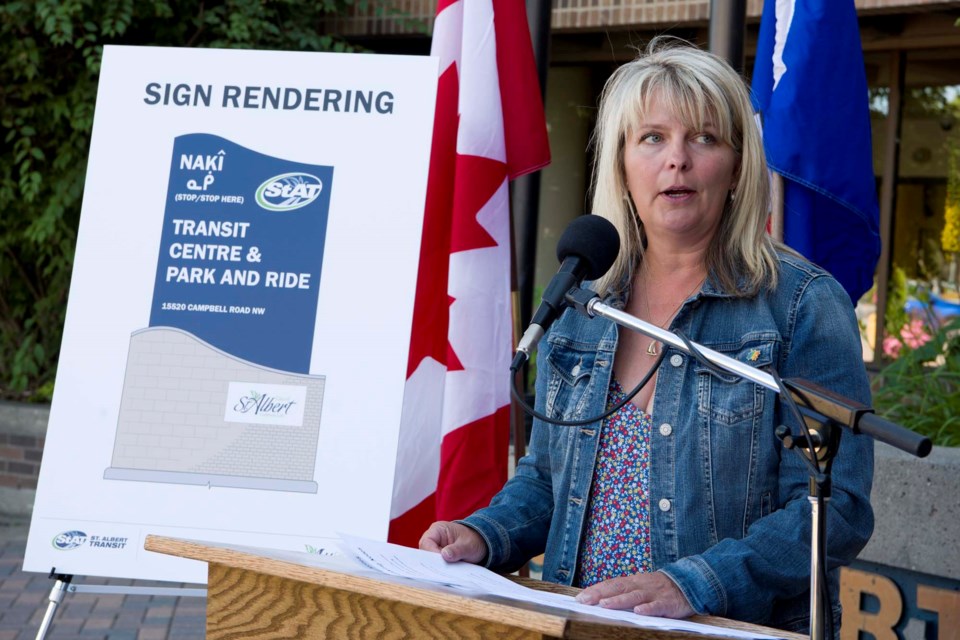The opening of the new Nakî (pronounced “na-gee”) Transit Centre & Park and Ride just outside of St. Albert will also spell the end for the Village Transit Station on Aug. 30, resulting in some route and service changes for transit riders.
Formerly known as the Campbell Road Park and Ride, the new centre will replace the existing Village Transit Station at Village Landing, which can no longer meet the parking demands, according to the city.
The Village Transit Station, closing Aug. 29, is about 2.6 kilometres from the new Nakî station, which is located south of Anthony Henday Drive within the City of Edmonton.
The project is a $30-million investment, with $20 million provided by provincial "Green Trip" grant funding and $10 million by the City of St. Albert through Municipal Sustainability Initiative (MSI) funding.
While 800 stalls will be built initially, the new site has space to expand that to a total of 1,600 stalls. The hub would also link into Edmonton’s LRT network should it ever get this far north.
“It's a perfect location that has been identified as a possible endpoint for the LRT in the future,” said Ettore Iannacito, St. Albert Transit service delivery manager.
“The new facility is state-of-the-art – it offers almost three times the number of parking spaces. We feel that just by the fact that more parking is available, we can attract more riders to the system.”
The old centre would soon become the home of Fire Hall No. 1, which is set to move from its downtown location in the near future.
Route changes
The closure of the Village Transit Station and reduction in ridership due to the COVID-19 pandemic will mean some changes for St. Albert riders.
All routes that stemmed from the Village station will now be housed at the Nakî station. Some routes north of the city, like A14, will transfer into a commuter line to continue service into Edmonton.
More bus stops will be installed at the former Village station to give residents who live in close proximity access to bus routes as well, Iannacito said.
“We will be putting in some new bus stops around that Village transit centre location to make it easier for our residents to access our service, who might have otherwise have walked into the facility,” he said.
“As a result, we've had to reorganize and realign our routes from the Village Transit Centre, to the new Nakî transit centre, and we think overall it will benefit our city and our residents.”
In January, St. Albert Transit presented the proposed roadmap to city council, which was approved. The new station should also make it easier for residents to commute between St. Albert and Edmonton.
"The routing change from Village Transit Station out to Nakî were just through necessity," said Dustin Creviston, transit operations co-ordinator for the city.
"We've gone through quite a bit of detail and the impact of any changes to the routings that would impact our customers, and they are found to be quite minor. In many cases, the reroutes that goes into Nakî are very similar to what is offered today going to Village."
More service hours
The city estimated in July that St. Albert Transit has lost approximately $140,000 per month from ticket sales, totalling $1.26 million, and $1.3 million in UPass revenue, due to the COVID-19 pandemic. Ridership had gone down nearly 90 per cent compared to pre-pandemic levels back in the spring.
Iannacito said ridership has since increased by 28 per cent of normal ridership, and with more people going back to workplaces and school, the city is expecting to see more people taking transit in the fall.
In September, St. Albert Transit will be operating an additional 70 hours of service, increasing the number of trips in the morning, evening and midday.
Buses will still be stopping every 30 minutes during peak hours, but these additional service hours will accommodate more trips where needed, Iannacito said.
“It's not unusual to add a lot of service (in the fall) but in this case, we're very mindful of our ridership. We're monitoring it on a weekly, monthly basis and changing things accordingly.”
–with files from Kevin Ma




